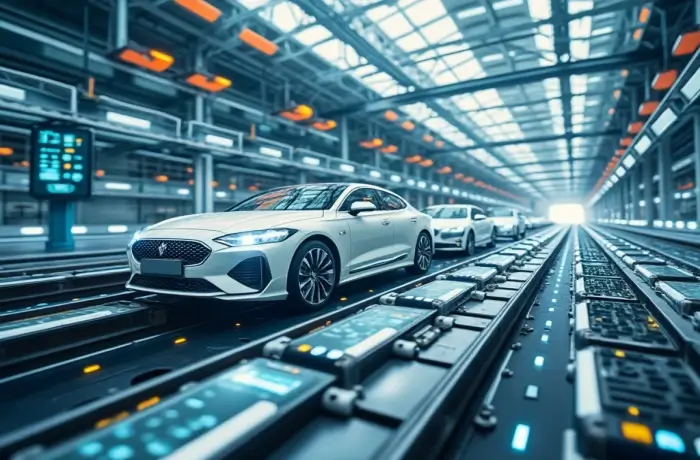Green Supply Chain Strategies in the Auto Industry

Lila Claybourne
Nov 19, 2024

Summary:
Introduction to the environmental impact of the auto industry and the importance of green supply chains.
Key elements that define a green supply chain in the automotive sector.
Strategies automakers are using to build sustainable supply chains.
The role of electric vehicles (EVs) in greening auto supply chains.
Challenges in implementing green supply chains and solutions.
Opportunities for innovation and growth within green supply chains.
The future outlook of green supply chains in the automotive industry.
Conclusion
FAQs about green supply chains in the auto industry.
Introduction: The Drive Toward Sustainable Supply Chains
The automotive industry is one of the largest contributors to global carbon emissions, accounting for approximately 20% of global emissions. From sourcing raw materials to manufacturing and logistics, the environmental impact of car production is significant. As climate change concerns rise, automakers face increasing pressure to reduce their carbon footprint and adopt more sustainable practices.
Why Are Green Supply Chains Important?
A green supply chain is crucial today because of growing consumer demand for eco-friendly products and stricter regulations on emissions. For instance, the European Union aims to cut carbon emissions by at least 55% by 2030, forcing automakers to rethink their supply chain strategies. In the U.S., the Corporate Average Fuel Economy (CAFE) standards are tightening, further pushing manufacturers toward greener practices.
Green supply chains minimize environmental harm at every stage—from raw material extraction to production, transportation, and recycling.
What Makes a Supply Chain Green in the Auto Industry?
A green supply chain focuses on minimizing negative environmental impacts while promoting sustainability across the entire lifecycle of a vehicle. This involves:
Eco-Friendly Sourcing: Automakers are increasingly using recycled materials. For instance, Ford uses recycled aluminum and plastics in several of its models.
Reducing Carbon Emissions: Companies like BMW have reduced CO2 emissions in their supply chains by 40% since 2019 by implementing renewable energy and reducing waste.
Energy Efficiency: General Motors has committed to using 100% renewable energy in its factories worldwide by 2040.
Recycling and Waste Reduction: Automakers like Toyota and Tesla recycle batteries and use end-of-life vehicles to reclaim valuable metals, reducing landfill waste.
Sustainability Certifications: Many automakers now adhere to ISO 14001 environmental management standards, which ensure sustainable practices across the supply chain.
Global regulatory frameworks such as the European Green Deal and CAFE standards push automakers to adopt greener practices, ensuring compliance with future environmental goals.
Strategies for Building a Green Supply Chain
Automakers are implementing various strategies to create greener supply chains:
1. Eco-Friendly Sourcing
To reduce the environmental impact of their supply chains, automakers are turning to sustainable materials:
Sustainable Metals: Companies like Ford use aluminum that is 100% recyclable, which helps reduce their carbon footprint during vehicle production.
Eco-Friendly Plastics: BMW uses plant-based polymers in interior components, reducing reliance on petroleum-based plastics.
2. Circular Economy Practices
The circular economy, which emphasizes reducing waste and reusing materials, is a growing trend:
Recycled Materials: In Europe, automakers using recycled materials have reduced their carbon footprint by up to 15%.
End-of-Life Recycling: Companies like Nissan and Renault focus on recycling electric vehicle (EV) batteries, giving them a second life or recovering valuable materials for reuse.
3. Energy-Efficient Manufacturing
Energy efficiency is another pillar of green supply chains:
Lean Production: Toyota's lean manufacturing process minimizes waste and optimizes production efficiency.
Renewable Energy in Factories: Tesla's Gigafactories are powered by solar energy, significantly reducing the environmental impact of vehicle production.
4. Green Logistics
Logistics and transportation are key areas where automakers are reducing emissions:
Electric Delivery Fleets: General Motors has electrified part of its delivery fleet, helping reduce emissions from transportation.
Optimizing Transport Routes: Automakers like BMW use AI to optimize logistics routes, reducing fuel consumption and overall emissions.
5. Supplier Collaboration
Collaboration with suppliers is crucial in ensuring sustainability throughout the supply chain:
Eco-Friendly Contracts: Automakers like Toyota and Ford have developed sustainability criteria for their suppliers, ensuring compliance with environmental goals.
Transparency in Sourcing: Blockchain technology is being used by companies like BMW to ensure transparency and sustainability in sourcing key materials like cobalt.
The Role of Electric Vehicles in Greening the Supply Chain
Electric vehicles (EVs) play a central role in green supply chains by reducing tailpipe emissions and driving innovation in material sourcing and recycling. However, they also bring new challenges, particularly in battery production and disposal.
Impact on Green Supply Chains
Lower Emissions: EVs help lower the carbon footprint of transportation. By 2025, EVs are expected to account for 20% of new car sales globally.
Battery Challenges: The sourcing of lithium, cobalt, and nickel for EV batteries poses environmental challenges. Recycling these batteries is crucial to reducing their environmental impact.
Battery Recycling Initiatives: Tesla's battery recycling program aims to reduce the need for new raw materials by recovering up to 92% of battery materials for reuse.
Challenges in Implementing Green Supply Chains
Implementing a green supply chain is not without its challenges:
Upfront Costs: Transitioning to sustainable practices can be expensive, with significant investment required in new technology and sustainable materials.
Sustainable Material Sourcing: Sourcing eco-friendly materials like recycled metals can be costly and logistically complex.
Global Supply Chain Management: Ensuring that all suppliers follow sustainable practices is challenging in a global supply chain, especially when dealing with varying regional regulations.
Battery Disposal: As electric vehicles become more popular, the disposal and recycling of lithium-ion batteries present significant environmental challenges.
Opportunities for Innovation and Growth
The push for green supply chains also presents new opportunities for innovation and growth:
Tech-Driven Sustainability: Technologies like AI and blockchain help automakers track sustainability metrics and optimize supply chain efficiency.
Consumer Demand: As more consumers prioritize sustainability, automakers are responding by ramping up the production of eco-friendly vehicles.
Industry Collaborations: Collaborations between automakers, governments, and suppliers are driving the development of industry-wide sustainability standards.
The Future of Green Supply Chains in the Auto Industry
The future of green supply chains in the auto industry is bright, with innovations in battery technology, renewable energy, and recycling paving the way for carbon neutrality:
Carbon-Neutral Factories: Automakers like BMW and GM are targeting carbon-neutral factories by the 2030s.
Solid-State Batteries: Emerging battery technologies like solid-state batteries promise to reduce the environmental impact of EVs even further.
Conclusion: The Road Ahead for Green Supply Chains
Green supply chain strategies are becoming essential to the future of the automotive industry. Companies are leading the way by embracing eco-friendly manufacturing practices, green logistics, and circular economy principles. These efforts will not only reduce emissions but also build a foundation for long-term sustainability.
For consumers and businesses alike, reducing environmental impact is no longer optional. If you're looking to align your car shipping needs with sustainability goals, AmeriFreight offers eco-friendly auto transport services. Get an instant quote today and ship your vehicle with a company that shares your commitment to a greener future!
FAQs about Green Supply Chains in the Auto Industry
What is a green supply chain in the auto industry?
A green supply chain focuses on minimizing environmental impacts at every stage, from raw material extraction to manufacturing and recycling. For example, automakers like Toyota use over 50% recycled materials in some vehicle models.
How are automakers reducing their carbon footprint?
Automakers are adopting renewable energy, sourcing sustainable materials, and utilizing lean manufacturing practices. For instance, BMW has cut CO2 emissions by 40% in its supply chain since 2019.
What are some examples of eco-friendly practices in car manufacturing?
Eco-friendly practices include using recycled metals, renewable energy in factories, and designing vehicles for easy recycling at the end of their lifecycle. Companies like Ford use aluminum that is 100% recyclable.
How do electric vehicles contribute to greener supply chains?
Electric vehicles produce zero tailpipe emissions, and automakers are working to recycle EV batteries and reduce reliance on new raw materials. Tesla recycles up to 92% of battery materials through its battery recycling initiatives.
What are the challenges automakers face when implementing green supply chains?
Challenges include the high upfront costs of transitioning to sustainable practices, sourcing eco-friendly materials, and ensuring global suppliers follow green standards. Battery disposal is also a growing concern for electric vehicles.
Why are green supply chains important for the future of the auto industry?
Green supply chains help automakers meet regulatory requirements, reduce environmental harm, and appeal to consumers who prioritize sustainability. Additionally, they offer long-term cost savings through energy efficiency and waste reduction.
Related Posts
















